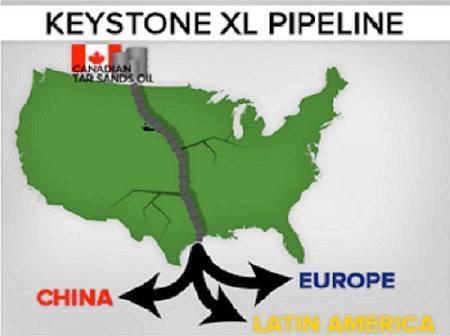The Keystone XL pipeline system is, upon completion, set to run from Western Canada’s tar sands into the United States to refineries in Illinois and down to the Gulf Coast of Texas. In total, the crude oil pipeline would run nearly 1,900 kilometres.
From the Gulf of Mexico, Canada’s crude oil can be shipped to Asia and Europe after the U.S. buys its share.
The $5.4-billion project was first proposed in 2008 by Calgary based TransCanada Corporation and has often been delayed by state sovereigntists, American Indian and environmental groups — who often declare victory when they exerted their civic power of the project such as when U.S. President Obama cautiously halted the pipeline’s progress in January 2012 amidst environmental concerns.
The U.S. House of Representatives approved the pipeline on Friday, November 14, 2014, in less than an hour.
This said, a vote by the Nebraska Supreme Court could hold the end-fate of the Keystone XL pipeline. The high court is expected to rule within a few weeks on whether or not the Nebraska Public Service Commission must review the final pipeline proposal before the state will allow it to cross its borders.
The pipeline system has four phases today and its financial backers have been waiting for a decision from U.S. President Barack Obama on whether they could move forward after the project was temporarily derailed in an effort to conduct in-depth study on the pipeline’s potential environmental impact and range of disaster should the pipeline burst at any point along its path from Western Canada to the Gulf of Mexico.
The U.S. government has been wrestling with the proposed concept and its potential impact on the economy and the environment; with U.S. politicians and legislature often putting forward a false dynamic as if Americans (and Canadians) had to choose between making money or protecting the environment.
This is one of the reasons why the pipeline approval process was delayed, temporarily halted in January of 2012 when President Obama rejected the application amid environmentalists’ concerns regarding the pipeline’s impact on Nebraska’s environmentally sensitive Sand Hills region.
Eventually the proposal passed the House of Representatives by a vote of 252 to 161.
American Indian groups whose territory the pipeline has to pass through have also sworn that they would halt the pipeline’s progress due to community impact and environmental concerns. This includes Indigenous groups such as the American Indian Movement (AIM).
Bryan Brewer, president of the Oglala Sioux band, was quoted in World Crunch where he explains that, “the Sioux’s opposition is not just to protect the spirits of their ancestors. ‘We receive water from Missouri through an aqueduct that the pipeline would cross at three different points,’ Brewer says. ‘These pipes will have leaks that would contaminate our water supply, and we need to protect it.'”
Another Native American elder, President Cyril Scott, from the Rosebud Sioux Band (Sicangu Lakota Oyate), of South Dakota likened the government supporting the Keystone XL pipeline to an “act of war” on Indigenous communities and the environment.
In a statement released on November 14, 2014, the Rosebud Sioux stated:
“The tribe has done its part to remain peaceful in its dealing with the United States in this matter, in spite of the fact that the Rosebud Sioux Tribe has yet to be properly consulted on the project, which would cross through tribal land, and the concerns brought to the Department of Interior and to the Department of State have yet to be addressed.”
“The House has now signed our death warrants and the death warrants of our children and grandchildren. The Rosebud Sioux Tribe will not allow this pipeline through our lands,” said President Cyril Scott of the Rosebud Sioux Tribe.
The U.S. Senate is voting today, Novemeber 18, on the pipeline proposal.
For more information on the resistance against the Keystone XL pipeline, please see the Facebook page: Stop the Keystone XL Pipeline, No More Dirty Tar Sands Oil




